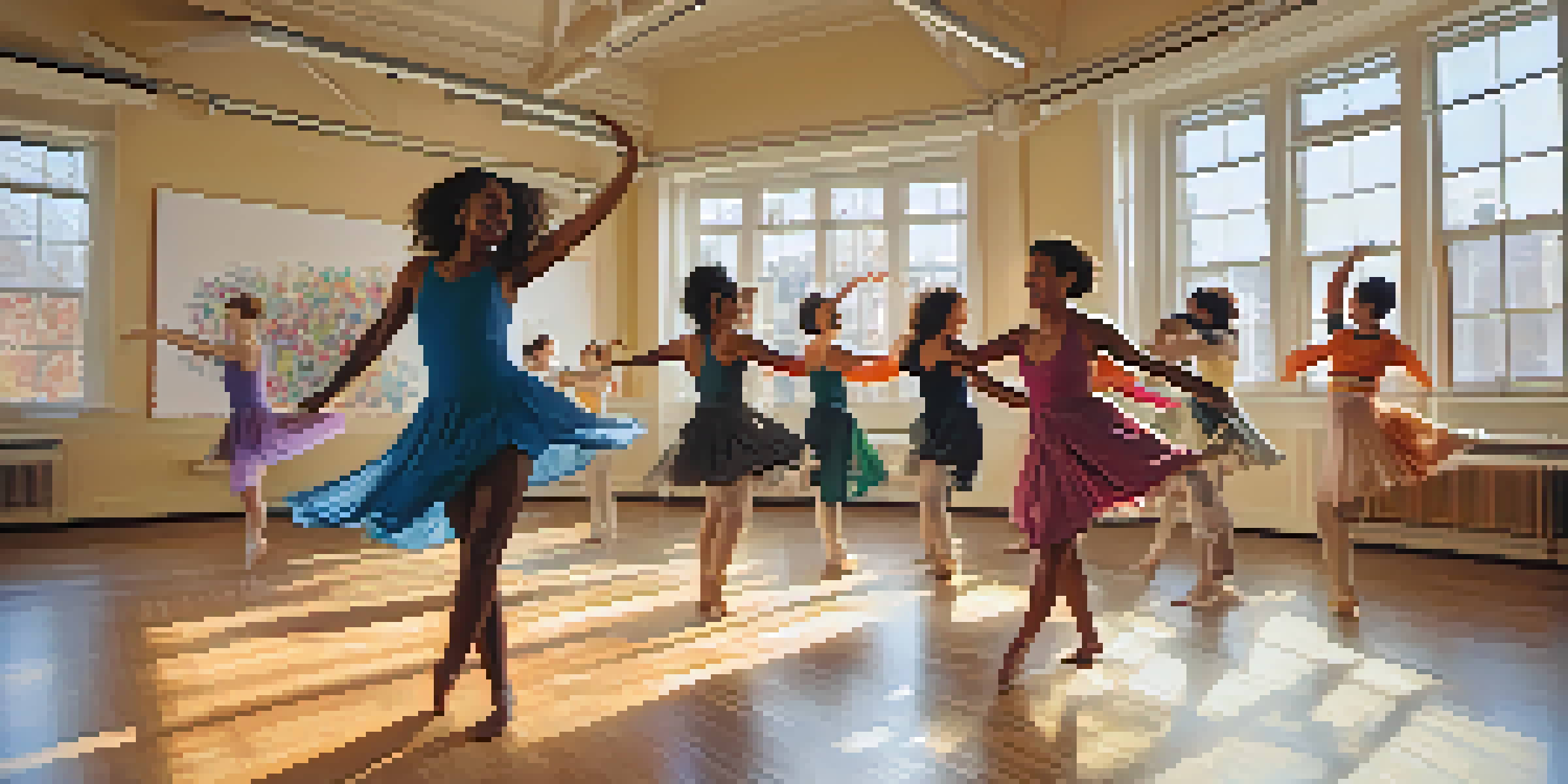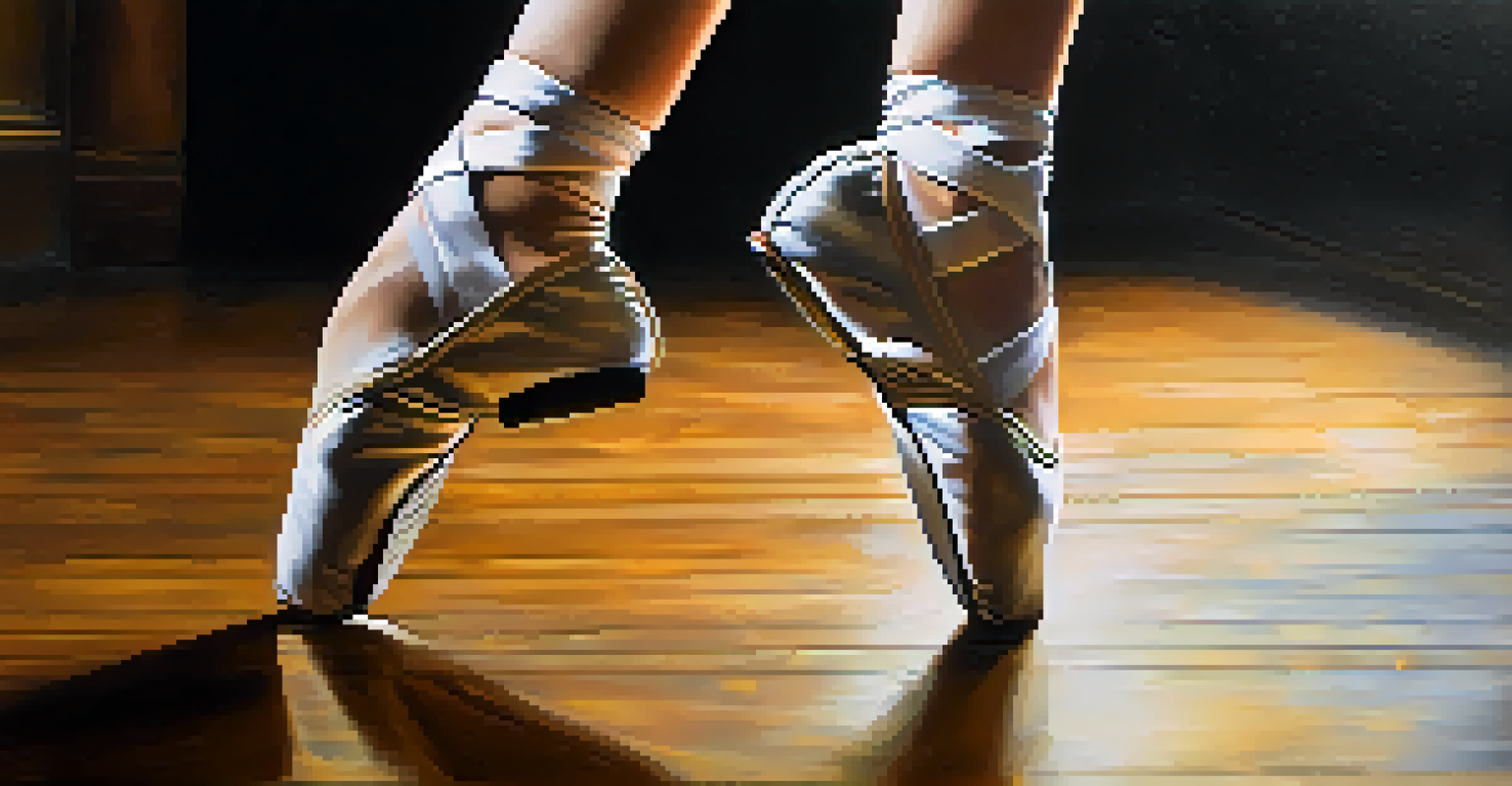The Healing Power of Dance: Connecting Through Movement

Understanding Dance as a Healing Art
Dance has long been recognized as a powerful form of expression and communication. Beyond its artistic value, it serves as a therapeutic medium that can promote emotional and physical healing. Whether it's through structured dance therapy sessions or spontaneous movement, the act of dancing can help individuals process their feelings and experiences, making it a vital tool for well-being.
Dance is the hidden language of the soul.
For many, dance acts as a form of self-care, allowing them to release pent-up emotions and stress. The rhythm of the music combined with movement can elevate one’s mood, creating a sense of freedom and joy. This release can be especially beneficial for those dealing with trauma, as it provides a safe space to explore feelings that might be difficult to articulate.
Additionally, dance encourages mindfulness, as participants focus on their bodies and movements in the present moment. This mindfulness aspect can lead to reduced anxiety and improved mental health, demonstrating that dance is not just a physical activity, but a holistic approach to healing.
The Science Behind Dance and Healing
Research has shown that engaging in dance can stimulate the release of endorphins, the body's natural feel-good chemicals. This biochemical reaction helps alleviate pain, reduce stress, and improve overall mood. Studies indicate that dancing regularly can enhance brain function, increase cognitive flexibility, and even improve memory, showcasing its profound impact on both body and mind.

Moreover, dance has been linked to decreased symptoms of depression and anxiety. A systematic review of dance interventions found significant improvements in mood and emotional well-being among participants. These findings underscore the importance of integrating dance into therapeutic practices for mental health.
Dance as Healing Expression
Dance serves as a powerful medium for individuals to express emotions and foster personal healing.
The social aspects of dance also play a crucial role in its healing properties. Group dancing fosters connection and community, which are essential for emotional support. These social interactions can combat feelings of loneliness and isolation, further enhancing the therapeutic effects of movement.
Dance Therapy: A Structured Approach to Healing
Dance therapy is a recognized therapeutic practice that combines dance and psychology to promote emotional, cognitive, and physical integration. Trained dance therapists guide individuals through movement to help them express feelings and explore personal narratives. This form of therapy can be particularly beneficial for those who find it challenging to communicate verbally.
Dance is the joy of movement and the heart of life.
During sessions, participants engage in improvisational movement and structured dance exercises designed to uncover emotions and facilitate healing. The non-verbal nature of dance allows for a unique exploration of feelings, often revealing insights that traditional talk therapy may not achieve. This makes dance therapy a valuable option for various populations, including children, seniors, and individuals with disabilities.
Furthermore, dance therapy is adaptable, meaning it can be tailored to meet the specific needs of each individual. Whether it’s addressing trauma, improving self-esteem, or enhancing social skills, dance therapy provides a versatile approach to healing through movement.
Cultural Connections: Dance Across the Globe
Different cultures around the world utilize dance as a form of healing and community building. From traditional tribal dances that connect participants to their heritage, to modern styles that reflect contemporary issues, dance serves as a universal language of expression. These cultural dances often tell stories of resilience, joy, and unity, illustrating how movement can foster connection.
In many Indigenous cultures, dance is an integral part of healing rituals, embodying the spirit and stories of the community. These ceremonies create a sense of belonging and collective healing, reinforcing the idea that dance is not just an individual practice but a communal one. This connection to culture adds depth to the healing power of dance.
Science Supports Dance Therapy
Research indicates that dance can enhance mental health by reducing anxiety and improving overall mood.
As globalization continues to influence dance forms, the blending of styles has created new opportunities for cross-cultural expression. This fusion allows individuals to explore and celebrate diversity through movement, further solidifying dance as a powerful tool for connection and healing across various communities.
Empowering Individuals Through Dance Workshops
Dance workshops provide an accessible platform for individuals seeking healing and connection through movement. These workshops often focus on improvisation and expression, allowing participants the freedom to explore their bodies and emotions without judgment. By engaging in these creative spaces, individuals can discover new aspects of themselves and foster a sense of empowerment.
In addition to personal growth, dance workshops promote social interaction and community building. Participants often form bonds as they share their experiences through movement, creating lasting connections that extend beyond the workshop. This sense of camaraderie can be incredibly healing, as it reinforces the notion that they are not alone in their journeys.
Moreover, these workshops can cater to various skill levels and backgrounds, making dance accessible to everyone. Whether someone is a seasoned dancer or a complete beginner, the focus on expression and creativity allows all participants to benefit from the healing power of dance.
Dance as a Means of Personal Expression
One of the most beautiful aspects of dance is its ability to serve as a personal expression of one’s inner self. Dance transcends language, allowing individuals to convey emotions, stories, and experiences that might be difficult to articulate. This form of self-expression can be particularly liberating, offering a sense of freedom and authenticity.
Through dance, individuals can explore their identities and navigate complex emotions. For instance, someone who has experienced grief may find solace in movement, using dance to honor their feelings and memories. This process of expression can lead to greater self-awareness and emotional resilience.
Community Connection Through Dance
Dance workshops and cultural practices promote social interaction, creating a sense of belonging and collective healing.
Moreover, the act of creating and performing dance allows individuals to reclaim their narratives. Whether it's through choreography or improvisation, dancers can assert their identities and experiences in a powerful way, turning personal challenges into art and healing.
The Future of Dance in Therapeutic Practices
As the understanding of dance's healing properties continues to grow, the future of dance in therapeutic practices looks promising. More mental health professionals are recognizing the benefits of incorporating dance into their treatment plans, leading to innovative approaches that combine movement with traditional therapies. This holistic perspective is reshaping how we view mental health and wellness.
Furthermore, advancements in technology are creating new opportunities for dance therapy. Virtual dance classes and online workshops are making healing through movement accessible to individuals regardless of location. This increased accessibility is essential, especially for those who may be hesitant to engage in traditional therapeutic settings.

Ultimately, the future of dance in healing lies in its ability to connect individuals, foster community, and promote self-expression. As we continue to explore the profound impact of movement on emotional and physical well-being, dance will undoubtedly remain a vital tool for healing and connection.